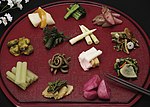Umeboshi (Japanese: 梅干し, pronounced [ɯmeboɕi], lit. 'dried ume') are pickled (brined) ume fruits common in Japan. The word umeboshi is often translated...
11 KB (1,319 words) - 12:44, 18 June 2024
nori (seaweed). Onigiri traditionally have sour or salty fillings such as umeboshi (pickled Chinese plum), salted salmon, katsuobushi (smoked and fermented...
18 KB (1,902 words) - 19:32, 27 October 2024
Umeboshi Rock (68°3′S 43°7′E / 68.050°S 43.117°E / -68.050; 43.117) is a rock exposure 4 miles (6 km) east-northeast of Akebono Rock on the coast of...
718 bytes (96 words) - 03:20, 6 November 2024
Japanese umeboshi. The term "chamoy", in this case, was supposedly coined by Teikichi Iwadare, a Japanese immigrant to Mexico who produced umeboshi made with...
10 KB (1,147 words) - 02:28, 21 July 2024
and umeboshi to flavor rice without any other side dishes. The metal bento boxes, once popular in Japan, were often corroded by the acid of umeboshi, eventually...
27 KB (3,052 words) - 02:12, 21 October 2024
with either umeboshi or bainiku (umeboshi paste), often in conjunction with green shiso leaves. A byproduct of umeboshi production is umeboshi vinegar, a...
51 KB (5,285 words) - 06:32, 21 August 2024
pickling method characterized by its short preparation time. Takuan (daikon), umeboshi (ume plum), turnip, cucumber, and Chinese cabbage are among the favorites...
7 KB (674 words) - 01:29, 16 June 2024
hoshiume (Japanese: 干し梅, dried plum) in Japan, where the salty and sour umeboshi is also popular. Li hing mui, along with li hing powder, is extremely popular...
9 KB (981 words) - 23:13, 27 October 2024
The Japanese variety, called umeboshi, is often used for rice balls, called onigiri or omusubi. The ume, from which umeboshi are made, is more closely related...
27 KB (2,529 words) - 07:37, 20 October 2024
consisted of rice with barley, meat or fish, pickled or fresh vegetables, umeboshi, shoyu sauce, miso or bean paste, and green tea. A typical field ration...
5 KB (645 words) - 02:44, 3 September 2024








